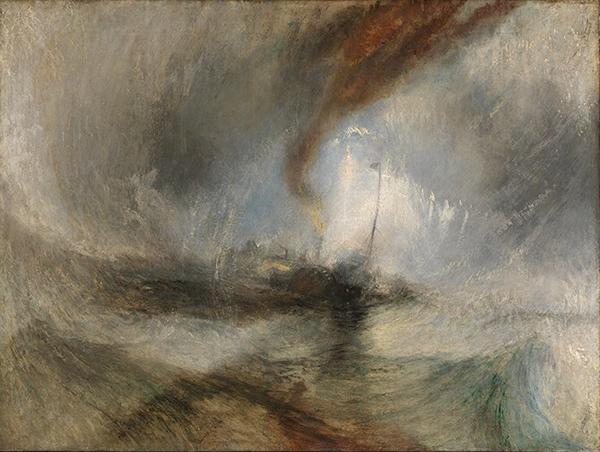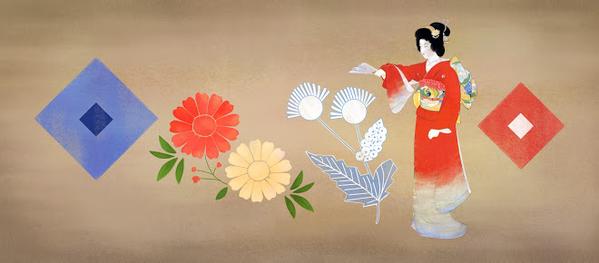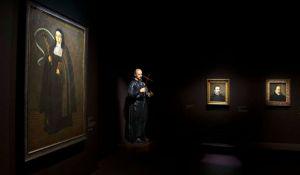Happy birthday J.M.W. Turner! #Turner #PaintingSetFree Currently @GettyMuseum http://www.getty.edu/mobile/gettyguide/center/exhibitions/turner/artifacts/248344_2111.html … More Thoughts to Follow...
Thursday, April 23, 2015
Wednesday, April 22, 2015
Google Doodle celebrates 140th birthday of Japanese artist Shoen Uemura
Google Doodle celebrates 140th birthday of Japanese artist Shoen Uemura 1875-1949 http://en.wikipedia.org/wiki/Uemura_Sh%C5%8Den …
Monday, April 20, 2015
Love Songs to the City
by Gregg Chadwick
Turn the nightly news on today, or scan the latest headlines on your iPhone, and it would seem that the world grows uglier each day. Eleven years ago, I wrote about my search for images of peace. I hearken back to those thoughts prompted by a memory of a time in Perth, Australia reading an art review concerning an exhibition about non-violence. The title of the review was "How do you paint peace?" Prompted by these ongoing concerns, I have been creating a new series of paintings using ideas of New Urbanism - Los Angeles in particular with peace as a subtext. What the amazing writer, actor, and teacher Claudette Sutherland, in my studio yesterday evening, called "Love Songs to the City."
Three books published in the last few years should be on every peacemaker's bookshelf: Steven Pinker's The Better Angels of Our Nature, Michael Shermer's The Moral Arc, and the Dalai Lama's Beyond Religion: Ethics for a Whole World. These three volumes begin with the premise that global violence on an historical timeline is not getting worse and that humanity is generally good.
Pinker's book successfully argues that the past was a much more brutal time. “The decline of violence may be the most significant and least appreciated development in the history of our species,” Pinker writes. As Elizabeth Kolbert notes in The New Yorker,"Another key development in Pinker’s narrative is the rise of cities, which in turn demanded stricter codes of conduct." This thought in Pinker's work connects to my painterly exploration of our new era in Los Angeles. As the architecture writer for the Los Angeles Times explains - there have been three distinct iterations of modern L.A.:
Shermer argues that because of the Enlightenment, thinkers consciously applied the methods of science to morally solve social struggles and that again, on an historical timeline, humanity is in the most moral period in history.
The Dalai Lama makes it clear in Beyond Religion: Ethics for a Whole World that an individual does not have to be religious to be ethical. Love and compassion are necessities for living. Compassion expresses deep sensitivity to the sufferings of others and a fierce drive to help alleviate those sufferings. Compassion is also the realization that we - human beings, animals, and the earth itself - are all interconnected.
Turn the nightly news on today, or scan the latest headlines on your iPhone, and it would seem that the world grows uglier each day. Eleven years ago, I wrote about my search for images of peace. I hearken back to those thoughts prompted by a memory of a time in Perth, Australia reading an art review concerning an exhibition about non-violence. The title of the review was "How do you paint peace?" Prompted by these ongoing concerns, I have been creating a new series of paintings using ideas of New Urbanism - Los Angeles in particular with peace as a subtext. What the amazing writer, actor, and teacher Claudette Sutherland, in my studio yesterday evening, called "Love Songs to the City."
%2B30%22x24%22%2Boil%2Bon%2Blinen%2B2015.jpg) |
Gregg Chadwick Third L.A. (for Christopher Hawthorne) 30"x24" oil on linen 2015 |
 |
Gregg Chadwick Thursday's Child 8"x6" oil on panel 2015 |
"The First Los Angeles, stretching roughly from the city’s first population boom in the 1880s through 1940, a city growing at an exponential pace built a major transit network and innovative civic architecture.
In the Second Los Angeles, covering the period from 1940 to the turn of the millennium, we pursued a hugely ambitious experiment in building suburbia –- a privatized, car-dominated landscape –- at a metropolitan scale.
Now we are on the cusp of a new era. In a series of six public events, some on the Occidental College campus and others elsewhere, the Third Los Angeles Project will explore and explain this new city. "
The Dalai Lama makes it clear in Beyond Religion: Ethics for a Whole World that an individual does not have to be religious to be ethical. Love and compassion are necessities for living. Compassion expresses deep sensitivity to the sufferings of others and a fierce drive to help alleviate those sufferings. Compassion is also the realization that we - human beings, animals, and the earth itself - are all interconnected.
Again I ask you:
How would you paint peace?
How would you create the idea of peace in your music? In your writing? In your life?How would you paint peace?
Saturday, April 18, 2015
Einstein's Taxidermy: Julia Elliott's "The New and Improved Romie Futch"
by Gregg Chadwick
Julia Elliott's new novel, The New and Improved Romie Futch, takes us on a Southern adventure that seems inspired by the absurdly picaresque world of John Kennedy Toole's A Confederacy of Dunces, the cyber/ historic cosmography of David Mitchell's Cloud Atlas, the dangerous science of Mary Shelley's Frankenstein, the obsessive hunt of Herman Melville's Moby Dick, and the eerily foreboding scape of Don De Lillo's White Noise, blended with the environmental warning of Rachel Carson's Silent Spring, all played to a soundtrack by the pioneering electronica musician Delia Derbyshire.
Romie Futch lives in an alternative yet still contemporary South Carolina, where hipsters seem to have swarmed South from Brooklyn and East from Portland to mingle and clash with characters that still haven't moved far from their High School glory days. Romie Futch is one of these down at the heels locals. Romie's ex-wife haunts his dreams and waking memories while creditors are poised to seize his house. Romie has become an expert at avoiding his less than booming taxidermy business with a daily regimen of internet distractions and it must be 5 o'clock somewhere beverage choices. Challenged in pecuniary matters, Romie decides to answer an ad searching for well paid research subjects for the mysterious Center for Cybernetic Neuroscience in Atlanta, Georgia.
Elliott's novel shifts locales here in a Tardis like fashion as Romie finds himself in an eerie world of lab coats and human experiments. Memories, always untrustworthy, erupt at inopportune times as Romie and his fellow test subjects gather nightly at dinner to spar with their new neuroscience-enhanced cognitive abilities and burgeoning artistic powers. The neurally enhanced taxidermist, vows to return to his hometown and finally pursue his long dormant dream of becoming an artist. Life and the lingering effects of the neural experiments on him and his fellow guinea pigs intervene as well as the shadowy form of a seemingly mythical thousand-pound feral hog that has been terrorizing Romie's home county.
Julia Elliott's language is rich and well played - at times darkly humorous, but also poignantly life affirming. Elliott's story is deftly crafted like Delia Derbyshire's haunting theme song for Doctor Who, originally composed by Ron Grainer, but transformed by Derbyshire into a futuristic swirl of spliced snippets of sound. Julia Elliott's The New and Improved Romie Futch is a literary swirl of Southern Gothic and dystopian Science Fiction that helps us laugh at our own foibles even as we try to create a better future. Highly recommended.
Julia Elliott’s The New and Improved Romie Futch goes on sale on October 19, 2015.
Her fiction has appeared in Tin House, the Georgia Review, Conjunctions, Fence, Puerto del Sol, Mississippi Review, Best American Fantasy, and other publications. She has won a Pushcart Prize and a Rona Jaffe Writer’s Award. Her short story collection, The Wilds, was published by Tin House Books in 2014, and she is currently working on a novel about Hamadryas baboons, a species that she has studied as an amateur primatologist. She teaches English and women’s and gender studies at the University of South Carolina in Columbia, where she lives with her daughter and husband. She and her spouse, John Dennis, are founding members of Grey Egg, an experimental music collective.
Julia Elliott's new novel, The New and Improved Romie Futch, takes us on a Southern adventure that seems inspired by the absurdly picaresque world of John Kennedy Toole's A Confederacy of Dunces, the cyber/ historic cosmography of David Mitchell's Cloud Atlas, the dangerous science of Mary Shelley's Frankenstein, the obsessive hunt of Herman Melville's Moby Dick, and the eerily foreboding scape of Don De Lillo's White Noise, blended with the environmental warning of Rachel Carson's Silent Spring, all played to a soundtrack by the pioneering electronica musician Delia Derbyshire.
Romie Futch lives in an alternative yet still contemporary South Carolina, where hipsters seem to have swarmed South from Brooklyn and East from Portland to mingle and clash with characters that still haven't moved far from their High School glory days. Romie Futch is one of these down at the heels locals. Romie's ex-wife haunts his dreams and waking memories while creditors are poised to seize his house. Romie has become an expert at avoiding his less than booming taxidermy business with a daily regimen of internet distractions and it must be 5 o'clock somewhere beverage choices. Challenged in pecuniary matters, Romie decides to answer an ad searching for well paid research subjects for the mysterious Center for Cybernetic Neuroscience in Atlanta, Georgia.
Elliott's novel shifts locales here in a Tardis like fashion as Romie finds himself in an eerie world of lab coats and human experiments. Memories, always untrustworthy, erupt at inopportune times as Romie and his fellow test subjects gather nightly at dinner to spar with their new neuroscience-enhanced cognitive abilities and burgeoning artistic powers. The neurally enhanced taxidermist, vows to return to his hometown and finally pursue his long dormant dream of becoming an artist. Life and the lingering effects of the neural experiments on him and his fellow guinea pigs intervene as well as the shadowy form of a seemingly mythical thousand-pound feral hog that has been terrorizing Romie's home county.
Julia Elliott's language is rich and well played - at times darkly humorous, but also poignantly life affirming. Elliott's story is deftly crafted like Delia Derbyshire's haunting theme song for Doctor Who, originally composed by Ron Grainer, but transformed by Derbyshire into a futuristic swirl of spliced snippets of sound. Julia Elliott's The New and Improved Romie Futch is a literary swirl of Southern Gothic and dystopian Science Fiction that helps us laugh at our own foibles even as we try to create a better future. Highly recommended.
Julia Elliott’s The New and Improved Romie Futch goes on sale on October 19, 2015.
Her fiction has appeared in Tin House, the Georgia Review, Conjunctions, Fence, Puerto del Sol, Mississippi Review, Best American Fantasy, and other publications. She has won a Pushcart Prize and a Rona Jaffe Writer’s Award. Her short story collection, The Wilds, was published by Tin House Books in 2014, and she is currently working on a novel about Hamadryas baboons, a species that she has studied as an amateur primatologist. She teaches English and women’s and gender studies at the University of South Carolina in Columbia, where she lives with her daughter and husband. She and her spouse, John Dennis, are founding members of Grey Egg, an experimental music collective.
Friday, April 17, 2015
Thursday, April 16, 2015
Sad News Upon Sad News: German Artist Juliane Noack Died in Germanwings Crash
Sad News Upon Sad News: German Artist Juliane Noack Died in Germanwings Crash - artnet News https://news.artnet.com/in-brief/artist-juliane-noack-died-in-germanwings-crash-288026 …?
Wednesday, April 15, 2015
Imelda Marcos Bought LACMA’s “Goya”
Imelda Marcos Bought LACMA’s “Goya” Los Angeles County Museum on Fire http://ARTINFO.com http://blogs.artinfo.com/lacmonfire/2015/04/15/imelda-marcos-bought-lacmas-goya/ …
Subscribe to:
Posts (Atom)








